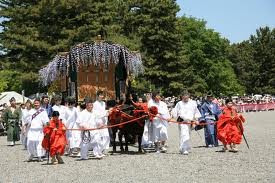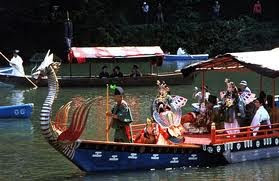[ . BACK to WORLDKIGO TOP . ]
:::::::::::::::::::::::::::::::::::::::::::::::::::::::::::::::::::::::::::::::::::::::::::::::::::
Festivals at the Kamo Shrine complex
***** Location: Kyoto
***** Season: Various, see below
***** Category: Observance
*****************************
Explanation
 Miyako Meisho Zue
Miyako Meisho Zue 都名所図会,
vol. 6 巻之六 後玄武再刻, 上加茂社 (上賀茂神社)
The Kamo Shrine complex:
Shimogamo Shrine 下鴨神社 and
Kamigamo Shrine 上賀茂神社 are both recognized as UNESCO World Heritage Sites. They are two of the most important shrines in Kyoto.
They are two of the oldest shrines in Japan.
 Kamo Shrine (賀茂神社, Kamo-jinja)
Kamo Shrine (賀茂神社, Kamo-jinja)
is a general term for an important Shinto sanctuary complex on both banks of the Kamo River in northeast Kyoto. It is centered on two shrines.
The two shrines, an upper and a lower, lie in a corner of the old capital which was known as the "devil's gate" (鬼門, kimon) due to traditional geomancy beliefs that the north-east corner brought misfortune. Because the Kamo River runs from the north-east direction into the city, the two shrines along the river were intended to prevent demons from entering the city.
Kamo-wakeikazuchi Shrine
賀茂別雷神社, Kamo-wakeikazuchi jinja)
(賀茂御祖神社, Kamo-mioya jinja)
The Kamo Shrine is so named because its rituals and festivals are designed to assist in the veneration of the Kamo family of kami and other associated deities; and Kamo kami (kami-no-Kamo) is referenced in other Shinto contexts. In the "Congratulatory Words of the Chieftain of Izumo," the "sacred grove of Kamo" is mentioned along with other wooded Shinto sanctuaries at Ō-miwa, Unade and Asuka:
Then, Ō-namochi-no-mikoto said:
"The Sovereign Grandhild will dwell peacefully
in the land of Yamato."
Thus saying, he attached his peaceful spirit
To a mirror of large dimensions,
Eulogizing it by the name
Yamato-no-Ō-mono-nushi-Kushi-mika-tama-no-mikoto,
And had it dwell in the sacred grove of Ō-miwa.
He caused the spirit of his son
Aji-suki-taka-hiko-ne-no-mikoto
To dwell in the sacred grove of Kamo in Kaduraki;
Caused the spirit of Koto-shiro-nushi-no-mikoto
To dwell in Unade;
And caused the spirit of Kayanarumi-no-mikoto
To dwell in the sacred grove of Asuka.
© More in the WIKIPEDIA !
Kamigamo Shrine (上賀茂神社, Kamigamo Jinja)
Upper Kamo Shrine
© More in the WIKIPEDIA !
source : Kamigamo Shrine HP
Shimogamo Shrine, Shimogamo Jinja (下鴨神社 / 下賀茂神社)
Lower Kamo Shrine (sometimes written with the Chinese character for duck.
© More in the WIKIPEDIA !
 sazare ishi さざれ石 boulder grown from pebbles
sazare ishi さざれ石 boulder grown from pebbles
"Kimigayo" (君が代) is the national anthem of post-1868 Japan.
君が代は 千代に八千代に さざれ石の
いわおとなりてこけの生すまで
Kimigayo wa
Chiyo ni yachiyo ni
Sazare-ishi no
Iwao to narite
Koke no musu made
May your reign
Continue for a thousand, eight thousand generations,
Until the pebbles
Grow into boulders
Lush with moss
Thousands of years of happy reign be thine;
Rule on, my lord, till what are pebbles now
By ages united to mighty rocks shall grow
Whose venerable sides the moss doth line.
Tr. Basil Hall Chamberlain
© More in the WIKIPEDIA !
There are various sazare-ishi in Japan.
The one for the Kimigayo is most probably referring to 岐阜県揖斐川町春日, now a park with the stone さざれ石公園.
:::::::::::::::::::::::::::::::::::::::::::::::::::::::::::::::::::::::::::::::::::::::::::::::::::::
According to the system of Shikinen Sengu, all shrines in the Shimogamo complex are meant to be rebuilt every 21 years. The purpose of this physical reconstruction is spiritual renewal.
Tadasu no mori, this lush, green forest is a hallmark of Shimogamo shrine.
source : Shimogamo Shrine HP
The name also refers to the ambit of shrine's nearby woods, which are vestiges of the primeval forest of
Tadasu no Mori 糺の森(ただすのもり、糺ノ森.
 Tadasu No Mori
Tadasu No Mori
which literally means "Forest of Correction," is a sacred grove associated with an important Shinto sanctuary complex known in Japanese as the Kamo-jinja, situated near the banks of the Kamo River just north of where the Takano River joins the Kamo River in northeast Kyoto city, Japan. The term Kamo-jinja in Japanese is a general reference to Shimogamo Shrine and Kamigamo Shrine, the traditionally linked Kamo shrines of Kyoto. The Kamo-jinja serve the function of protecting Kyoto from malign influences.
The ambit of today's forest encompasses approximately 12.4 hectares, which are preserved as a national historical site . It is today the last remnant of a primeval forest which is reputed to have never been burned down. The forest has, in fact, suffered some damage over the centuries when all of Kyoto was burned during successive revolts and wars but the forest growth has rebounded again and again. The forest is left to grow in its natural state. It is neither planted nor pruned.
The forest in ancient times comprised approximately 4,950,000 square meters of virgin forest. Due to wars during the Middle Ages and a supreme edict in the 4th year of the Meiji era, it was reduced to its present area of approximately 124,000 square meters.
The wooded area that is called by the name Tadasu-no-mori today lies on the grounds of Shimogamo Shrine, one of the seventeen historical sites in and around Kyoto which in 1994 were designated by UNESCO as Historic Monuments of Ancient Kyoto.
source : www.medical-answers.org
hotarubi no chakai 蛍火の茶会 tea ceremony and fireflies
in June
There are performances of court and other traditional music with ritual dancing, a demonstration of kimonos in 12 layers (juuni-e), tea ceremony and then fireflies are released to freedom. (This is a good deed said to improve one's karma in the next world.)
. . . CLICK here for Photos !
:::::::::::::::::::::::::::::::::::::::::::::::::::::::::::::::::::::::::::::::::::::::::::::::::::::

Busha Shinji (歩射神事, archery ritual) at Shimogamo Shrine (下鴨神社).
The arrow will overleap the huge gate at the left side
- Shared by Taisaku Nogi -
Joys of Japan, 2012
Busha Shinji
Shrine priests use bows and arrows to ward off evil spirits. Other arrow shooting rituals are also held.
source : www.kyotoguide.com
賀茂別雷神社(上賀茂神社)
text by 千玄室
source : www.kamigamojinja.jp/sengu
Kamo Wake Ikazuchi Jinja
賀茂別雷神社 (かもわけいかづちじんじゃ)
source : www.kyoto.zaq.ne.jp
::::::::::::::::::::::::::::::::::::::::::::::::::::::::::::::::::::::::::::::::::::::::::::::::::::::::::::::::::::::::::::::::::::

yakuyoke no omamori 厄除けの御守り
amulet to ward off evil
. . . CLICK here for amulet Photos !
. Yakuyoke - Amulets to ward off evil .
::::::::::::::::::::::::::::::::::::::::::::::::::::::::::::::::::::::::::::::::::::::::::::::::::::::::::::::::::::::::::::::::::::
kigo for early summer

賀茂の競べ馬 -
Miyako Meisho Zue 都名所図会,
kurabeuma, kurabe uma 競べ馬 horse race
. Kamo keiba 賀茂競馬(かもけいば)
horse race at Kamo shrine
"The Ritual of the Racehorses"
kurabeuma, kurabe uma 競べ馬 (くらべうま) horse race
kisoi uma きそい馬(きそいうま)
koi uma きおい馬(きおいうま)
muda hashiri 空走り(むだはしり)"free run"
kachiuma 勝馬(かちうま)winning horse
makeuma 負馬(まけうま)loosing horse
hashiri uma 走り馬(はしりうま)running horse
ashizoroe 足揃(あしぞろえ) "getting the legs together"
May 5
. . . . .
 . Aoi Matsuri 葵祭 Aoi Festival
. Aoi Matsuri 葵祭 Aoi Festival
May 15
Shimogamo and Kamigamo shrine in Kyoto
..... Kamo no matsuri 賀茂祭(かものまつり)
source : Kamo-sai (Aoi-matsuri)
Kamo Mikage Matsuri
賀茂御蔭祭 (かもみかげまつり)
"honorable shadow festival" mikage matsuri
mi-aregi 御生木(みあれぎ)
shibakiri shinji 芝切神事(しばきりしんじ)
"Lawn Cutting Ceremony"
May 15
(during the Aoi Matsuri Festival)
. . . . .
kigo for late summer
. Shimogamo no misogi
下賀茂の御祓 (しもがものみそぎ)
Shimogamo purification rituals
visiting for the Mitarashi festival, mitarashi moode
御手洗詣 みたらしもうで
Tadasu no suzumi 糺の納涼(ただすのすずみ)
coolness of the Tadasu forest
mitarashi dango 御手洗団子(みたらしだんご)
rice dumplings
Nagoshi-no-harae
June 30
Maybe related to Christian baptism rituals?
. The Hata Clan 秦氏 Hata Uji .
and the Christian connection
:::::::::::::::::::::::::::::::::::::::::::::::::::::::::::::::::::::::::::::::::::::::::::::::::::
kigo for early autumn
 . yatori shinji 矢取り神事
. yatori shinji 矢取り神事
Shimogamo Shrine Arrow Ceremony
Beginning of August
:::::::::::::::::::::::::::::::::::::::::::::::::::::::::::::::::::::::::::::::::::::::::::::::::::
kigo for the New Year
. hatsumari 初鞠 first kick-ball bame
..... kemari hajime 蹴鞠初め
January 4 at Shimogamo Shrine in Kyoto.
. . . . .
Kamigamo Nentoosai
上賀茂燃燈祭 (かみがもねんとうさい)
"Lantern Festival at Kamigamo"
hatsune no tamabooki
初子の玉箒(はつねのたまぼうき)
"precious broom on the first day of the rat"
A broom (brush) used to clean the silkworm room for the first time on the first day of the rat. The broom was made of Chinese lespedeza, Lespedeza cuneata (medohagi蓍萩) and first pine seedlings.
 source : unokanda
. Pulling Pine Seedlings (komatsu hiki)
source : unokanda
. Pulling Pine Seedlings (komatsu hiki)
. . . . .
Kamigamo otana kazari
上賀茂御棚飾 (かみがもおたなかざり)
shelf decorations at Kamigamo shrine
January 14
This ritual dates back to the Heian period.
After making donations to the four districts, they were divided into six districts.
On this day, offerings from the six districts were made.
Lately on one shelf offerings of fish, foul, rice and other food items are made and ritual music is played.
:::::::::::::::::::::::::::::::::::::::::::::::::::::::::::::::::::::::::::::::::::::::::::::::::::::
:::::::::::::::::::::::::::::::::::::::::::::::::::::::::::::::::::::::::::::::::::::::::::::::::::::
Karasu-zumo "Crow Sumo (wresling celemony)"
烏相撲(からすずもう)
karasu sumoo
September 9, Kamigamo Shrine

In this very unusual ritual, shrine officials imitate the voice of crows and their manner of jumping to the side, then children perfom sumo for the entertainment of the Kami. It has been designated by the city of Kyoto as an "Intangible Cultural Property".
source : www.kamigamojinja.jp
. . . . .
More festivals at Shimogamo Shrine
New Year's Festivities
Kinensai Matsuri (Toshigoi Matsuri)
Mitarashi Matsuri
Meigetsu Kangen Sai
Ohitaki Sai
Yakushu Wakamizu shinji “medicine wine, young water.”
source : www.shimogamo-jinja.or.jp
:::::::::::::::::::::::::::::::::::::::::::::::::::::::::::::::::::::::::::::::::::::::::::::::::::::
Dragon Ema for 2012
 Shared by Promenade in Kyoto
Joys of Japan
. Dragon Ema votive tablets - 2012 .
. The Dragon Art Gallery .
*****************************
Worldwide use
*****************************
Shared by Promenade in Kyoto
Joys of Japan
. Dragon Ema votive tablets - 2012 .
. The Dragon Art Gallery .
*****************************
Worldwide use
*****************************
Things found on the way
. "Kamo Dolls (kamo ningyo 加茂人形)
Willow Dolls (yanagi ningyo 柳人形)
. Kannabi 神奈備 "purified place"
*****************************
HAIKU
御座をはけこよひ初子の玉箒
goza o hake koyoi hatsune no tamabooki
cleaning the mats
tonight with a precious broom
on the first day of the rat
In the Haiku Collection Enoko Shuu 犬子集(1633)

Enokoshu, part of the Shoki Haikai Shu 初期俳諧集
江戸初期の俳諧集
17 maki in 5 volumes
:::::::::::::::::::::::::::::::::::::::::::::::::::::::::::::::::::::::::::::::::::::::::::::::::::
 黄昏に孫と散歩の鴨の川
Twilight stroll
黄昏に孫と散歩の鴨の川
Twilight stroll
Old couple and a grandson
Along Kamo river
Esho Shimazu
Joys of Japan, February 2012
*****************************
Related words
*****
. Kyoto (Hana no Miyako)
BACK : Top of this Saijiki
:::::::::::::::::::::::::::::::::::::::::::::::::::::::::::::::::::::::::::::::::::::::::::::::::::::::::::::::::::::::::::
[ . BACK to DARUMA MUSEUM TOP . ]
[ . BACK to WORLDKIGO . TOP . ]
:::::::::::::::::::::::::::::::::::::::::::::::::::::::::::::::::::::::::::::::::::::::::::::::::::::::::::::::::::::::::::











































